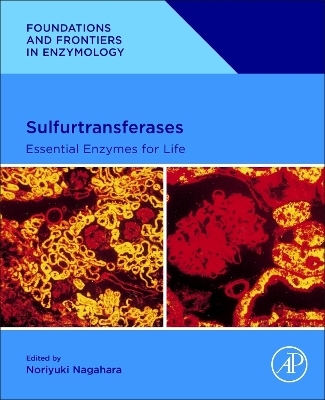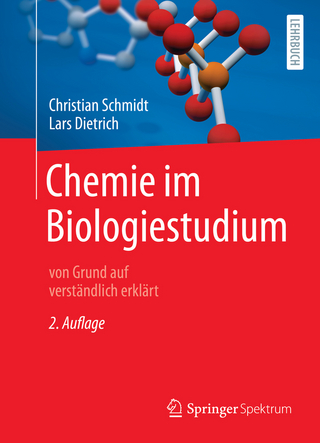
Sulfurtransferases
Academic Press Inc (Verlag)
978-0-443-18827-5 (ISBN)
Dr. Noriyuki Nagahara is an Associate Professor at the Isotope Research Institute of Nippon Medical School in Tokyo, Japan. He studies the chemical pathogenesis of lung cancer, along with chemical enzymology and molecular biology in the Department of Biochemistry at Nippon Medical School, and environmental medicine in the Department of Environmental Medicine, Nippon Medical School. He has investigated several enzymes, including purine nucleoside phosphorylase, xanthine oxidase, porphobilinogen synthase, thiosulfate sulfurtransferase (rhodanese), and 3-mercaptopyruvate sulfurtransferase (MST). In the course of his research, he found that MST was evolutionally related to rhodanese using protein engineering techniques. He also clarified the cellular and subcellular localization of MST, its enzyme kinetics, antioxidant properties, the characteristics of a cysteine with low redox potential in its catalytic site, and its mechanisms of polysulfide and hydrogen sulfide production. Dr. Nagahara is the author of over 70 original publications, and 6 books, and serves on the editorial boards of several journals, including Scientific Reports. Dr. Munishwar Nath Gupta earned his PhD from Indian Institute of Science, Bengaluru, and completed post-doctoral positions at Massachusetts Institute of Technology (USA), University of Minnesota (USA), Lund University (Sweden), and University of Technology of Compiegne (France). He has taught chemistry, biochemistry, and biotechnology at Indian Institute of Technology, Delhi, between 1975-2016. He was awarded the National Science Talent fellowship (India) and Fellowships of National Academy of Sciences and Indian National Science Academy. He has edited three books on thermostability of enzymes, non-aqueous enzymology and affinity-based separation methods (published by Springer/Birkhauser). He was an Associate Editor of Biocatalysis and Biotransformation (Taylor and Francis) and founding and former editor-in-chief of Sustainable Chemical Processes (Springer). He’s served on editorial boards of several national and international journals and acted as a consultant to Novozyme (Denmark), Dabur (India), and other international companies. His research interests include applied biocatalysis and interfaces of biochemistry with nanotechnology.
ContributorsPreface
1. 3-Mercaptopyruvate sulfurtransferase: the molecular and functional propertiesNoriyuki Nagahara and Takaaki Ito
Adaptation of living organisms to oxidative and chemical environments Molecular evolution of sulfurtransferases MST and evolutionarily related enzymes of TST Molecular, kinetic, and functional properties of MSTProperties of the promoter region of the MST geneMultiple functions of MST related to catalysisPossible production mechanism of H2S and polysulfide from MSTLocalization of MST in rat and mouseMST expression in mouse developmental stagesMST-knockout mouseFuture perspectiveAcknowledgmentsReferencesFurther reading
2. 3-Mercaptopyruvate sulfurtransferase: a review of past and present perspectivesY. Ogasawara
Discovery and earlier characterization of 3-MSTComparison of 3-MST with thiosulfate sulfur transferase (rodanase)Purification and catalytic reactionAmino acid sequence and protein structurePhysiological role of 3-MST3-MST and rhodanese in selenium metabolismMethods for measuring 3-MP and 3-MST activitiesClinical studies on 3-MST and the construction of 3-MST knockout miceLocalization and significance of 3-MST in the central nervous systemInvolvement of 3-MST in sulfane sulfur (bound sulfur) generationReferences
3. The tales of fungal sulfurtransferases: lost, found, and stolenSebastian Piłsyk
References
4. 3-Mercaptopyruvate sulfurtransferase produces hydrogen sulfide (H2S), polysulfides (H2Sn), and other S-sulfurated signaling moleculesHideo Kimura
Introduction3MST produces H2S H2S and H2Sn regulate neuronal transmission 3MST as H2Sn producing enzyme Signaling via S-sulfuration of target proteins Energy formation versus its suppression by H2S Cytoprotection against oxidative stressInvolvement of 3MST and H2S in the pathogenesis of schizophreniaPerspectivesReferences
5. A persulfide shield: an endogenous reactive sulfur species in the forefront in the electrophile detoxification pathwayHisyam Abdul Hamid, Tsuyoshi Takata, Tetsuro Matsunaga and Takaaki Akaike
IntroductionBiosynthesis of biological polysulfidesA “persulfide shield: proposed as an electrophile defense mechanismRSS versus heavy metalsRSS versus alkylating agents and xenobioticsFuture directions of RSS-based researchAcknowledgmentReferences
6. Thiosulfate sulfurtransferase: a model of essential enzyme with potential applications in medicine and biotechnologySilvia Buonvino, Giulia Cinotti and Sonia Melino
IntroductionTST/rhodanese structure: a model for studying the protein foldingTST in the cell metabolismDiseases related to TST dysregulationTST in biotechnologyReferencesFurther reading
7. Chemical approaches to discover selective inhibitors of sulfurtransferases and transsulfuration enzymesEita Sasaki and Kenjiro Hanaoka
IntroductionWidely used inhibitors of CBS, CSE, 3MST, and rhodaneseChemical approaches to discover new inhibitorsConclusionsReferences
8. New insight into the role of TST-derived hydrogen sulfide, a key regulator of mesenteric homeostasis, in health and during chronic fructose intakeOleh Revenko, Yaroslav Pavlovsky, Iryna Kovalchuk, Maryana Savytska and Oksana Zayachkivska
IntroductionThe beneficial role of TST-derived hydrogen sulfideSummaryReferencesFurther reading
9. The S-adenosyl-L-methionine radical enzymes: the lipoic acid synthase and the biotin synthaseAnna Bilska-Wilkosz
Metabolic role of lipoic acidBiosynthesis of lipoic acidMetabolic role of biotinThe biosynthetic pathway of biotinRadical S-adenosyl-L-methionine superfamily of enzymesThe lipoyl synthaseThe biotin synthaseReferences
10. Sulfur transferases in the pathways of molybdenum cofactor biosynthesis and tRNA thiolation in humansSilke Leimkühler and Moses Olalekan Ogunkola
IntroductionThiolation of tRNAThiocarboxylate formation on the URM1 proteinMoco biosynthesisMOCS3NFS1TUM1MTU1CTU1ConclusionsReferencesIndex
| Erscheinungsdatum | 12.05.2023 |
|---|---|
| Reihe/Serie | Foundations and Frontiers in Enzymology |
| Mitarbeit |
Herausgeber (Serie): Munishwar Nath Gupta |
| Verlagsort | San Diego |
| Sprache | englisch |
| Maße | 191 x 235 mm |
| Gewicht | 450 g |
| Themenwelt | Naturwissenschaften ► Biologie ► Biochemie |
| Naturwissenschaften ► Physik / Astronomie ► Angewandte Physik | |
| ISBN-10 | 0-443-18827-0 / 0443188270 |
| ISBN-13 | 978-0-443-18827-5 / 9780443188275 |
| Zustand | Neuware |
| Informationen gemäß Produktsicherheitsverordnung (GPSR) | |
| Haben Sie eine Frage zum Produkt? |
aus dem Bereich


